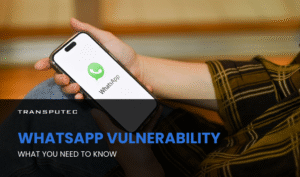Written by KRITIKA SINHA | MARKETING
In a world where cyber threats are increasingly sophisticated, knowing how to spot a scam is crucial to safeguarding your personal and professional information. As technology advances, so do cybercriminals’ tactics in creating scam emails, messages, and calls that look convincingly real. This guide explores how to detect these scams effectively, avoid common pitfalls, and protect yourself and your business.
At Transputec, we’re committed to helping you protect yourself from fraud. This comprehensive guide will teach you how to spot a scam across various communication channels.
Transputec: Your Partner in Cybersecurity
At Transputec, we specialise in cybersecurity solutions designed to protect individuals and businesses from cyber threats. Our team of experts can help assess vulnerabilities and provide tools to combat phishing and other scams.
If you’re concerned about your cybersecurity, get in touch with us today to secure your digital assets.
Why Cyber Scams Are on the Rise
Cybercrime is booming, with over 300,000 phishing attempts recorded daily worldwide. As more people rely on digital communication, the avenues for scams have multiplied. Email, SMS, and phone scams offer direct lines for attackers to exploit unsuspecting individuals or businesses. Research shows that 97% of people cannot correctly identify a phishing email, making how to spot a scam a skill everyone should master.
The cost of falling for a scam can be substantial. Businesses face severe financial loss, data breaches, and damaged reputations, while individuals risk identity theft and financial exploitation.
Key Indicators of a Scam Email
When it comes to how to spot a scam email, there are specific red flags to look for:
1. Suspicious Sender Email Address
- Scammers often use email addresses that closely resemble legitimate ones but have minor alterations, such as replacing letters with numbers (e.g., “Transputec” vs. “Tr4nsputec”).
2. Urgent or Threatening Language
- Scam emails frequently use language intended to panic recipients into acting quickly. Phrases like “urgent,” “your account will be locked,” or “final notice” are red flags.
3. Poor Grammar and Spelling
- Many phishing emails are poorly written. Look for spelling errors, awkward phrasing, or strange formatting. Legitimate companies typically have high standards for communication.
4. Unusual Links or Attachments
- Hover over links to check if they lead to legitimate websites. Scam links often look slightly misspelt or lead to completely unrelated domains. Downloading attachments can expose your device to malware.
5. Requests for Personal Information
- Legitimate companies rarely ask for personal information, like passwords, via email. Be cautious if you receive requests for sensitive information in an email.
Pro Tip: Always verify directly with the company if an email seems suspicious. Contact them through official channels, not the contact information provided in the suspicious email.
Protect your Business 24/7 with Transputec!
Our Managed SOC Cost Calculator estimates potential expenses for security tools and other costs based on your requirements.
How to Spot a Scam Text Message
Scammers use text messages, or “smishing,” to lure victims with promises of prizes or threats about account issues. Here’s how to spot a scam text message:
1. Strange Phone Numbers
- Scam messages often come from numbers that appear unusual, either very long or with country codes that do not match local numbers.
2. Urgency or Too-Good-To-Be-True Offers
- Phrases like “You’ve won!” or “Act now to claim your reward” are often used. These messages play on excitement or fear to prompt immediate responses.
3. Links to Unknown Websites
- Scammers use shortened URLs to disguise malicious links. Avoid clicking any link from unknown senders, especially if it looks strange.
4. Requests for Personal Information
- Messages asking for your Social Security number, password, or other sensitive information are likely scams. Legitimate companies rarely use SMS for such requests.
Red Flags for Scam Phone Calls
Phone scams, or “vishing,” aim to manipulate victims over the phone by impersonating trusted authorities, like banks or tech support. To understand how to spot a scam call, look for these signs:
1. Caller Claims Immediate Action is Needed
- Scammers often claim there’s a security breach on your account and urge you to take action immediately to avoid consequences.
2. Requests for Payment or Sensitive Information
- Scammers may ask for credit card details or direct you to make payments over the phone. Financial institutions rarely make such requests without other forms of confirmation.
3. Caller ID Spoofing
- Scammers can fake caller IDs to appear as legitimate businesses. If you receive a suspicious call, hang up and contact the company through their official customer service number.
4. Pressure to Keep the Call Confidential
- Scammers might discourage you from discussing the call with anyone. This tactic prevents you from getting second opinions or realising it’s a scam.
Pro Tip: Don’t trust caller ID alone. Caller ID can be manipulated to look like the call is from a reputable source.
What to Do if You Suspect a Scam
Knowing how to spot a scam is essential, but responding effectively is just as critical. Here’s what to do if you suspect a scam attempt:
- Don’t Respond or Click – Avoid responding to scam emails or text messages, as doing so can confirm your contact information for scammers.
- Report the Scam – Notify relevant authorities or report directly to your email provider. Reporting can help track down and prevent future scams.
- Change Your Passwords – If you engage with the scammer, update your passwords to protect your accounts.
- Monitor Your Accounts – Look for any suspicious activity in your bank or online accounts.
Conclusion
Learning how to spot a scam is an essential skill in today’s digital landscape. By staying informed and vigilant, you can protect yourself and your business from increasingly sophisticated fraud attempts. Remember, if something seems too good to be true or feels suspicious, trust your instincts and verify before taking action.
At Transputec, we’re committed to helping you navigate the complex world of cybersecurity. Don’t let scammers catch you off guard. Contact us today to get in touch with an expert and start building a robust defence against fraud.

Secure Your Business!
Ready to explore how we can enhance your security posture? Contact us today to speak with one of our experts.
FAQs
How can I verify if an email is a scam?
Check the sender’s email address carefully, look for grammar errors, hover over links before clicking, and never share personal information. If unsure, contact the company directly.
What should I do if I click a link in a scam email?
If you click a suspicious link, change your passwords immediately, enable two-factor authentication on your accounts, and monitor for unusual activity.
How do scammers use text messages to steal information?
Scammers send messages with urgent offers or fake alerts, prompting users to click on links or provide sensitive information. Be cautious of unknown numbers and unsolicited messages.
Can caller ID be faked?
Yes, caller ID spoofing allows scammers to impersonate legitimate organisations. Always verify with the company directly if a call seems unusual.
How does Transputec help protect against scams?
Transputec offers customised cybersecurity solutions to prevent phishing, malware, and other digital threats. Our experts provide assessments and training to keep you safe.







